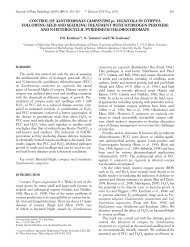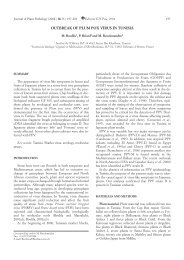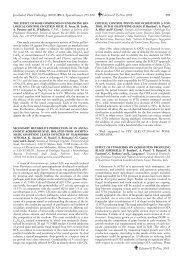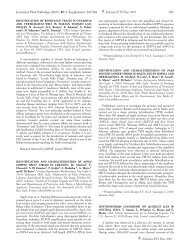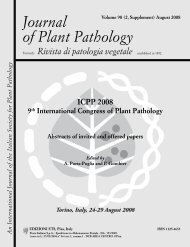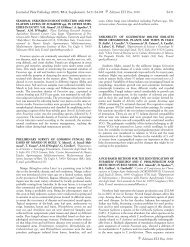Journal of Plant Pathology - Sipav.org
Journal of Plant Pathology - Sipav.org
Journal of Plant Pathology - Sipav.org
Create successful ePaper yourself
Turn your PDF publications into a flip-book with our unique Google optimized e-Paper software.
<strong>Journal</strong> <strong>of</strong> <strong>Plant</strong> <strong>Pathology</strong> (2011), 93 (1, Supplement), S1.39-S1.42 Edizioni ETS Pisa, 2011 S1.39<br />
THE BIOGENIC AMINE HISTAMINE: PHYSIOLOGICAL EFFECT<br />
AND CONCENTRATIONS IN WINE<br />
I. Schneider 1 , A. Ans<strong>org</strong>e 2 and P. Herr 3<br />
1<br />
E. Begerow GmbH & Co., Research and Development, An den Nahewiesen 24, 55450 Langenlonsheim, Germany<br />
2<br />
Geisenheim Research Institute, Soil Science Division, Rüdesheimerstrasse, 65366 Geisenheim, Germany<br />
3<br />
DLR Rheinpfalz, Breitenweg 71, 67435 Neustadt an der Weinstrasse, Germany<br />
SUMMARY<br />
Wine samples were collected from German wineries<br />
during a two-year study (2007/2008) and their histamine<br />
concentration was determined. The data from<br />
2007 showed that between two wineries either no histamine<br />
or a low concentration <strong>of</strong> it was found when with<br />
starter cultures (Oenococcus oeni) were used or maximum<br />
values <strong>of</strong> 1,01 up to 7,30 mg/l were detected when<br />
spontaneous MLF (malolactic fermentation) occurred.<br />
In the 2008 survey maximum histamine concentrations<br />
ranged between 1,85 and 2,24 mg/l when the musts<br />
were inoculated with starter cultures and 2,77 to 3,37<br />
mg/l in the case <strong>of</strong> spontaneous MLF. The two-year<br />
study showed that inoculation with starter cultures reduced<br />
concentrations <strong>of</strong> histamine in wine but if no<br />
spontaneous MLF-bacteria were present, there was no<br />
histamine in the wines.<br />
Key words: amines, histamines, health, wine quality.<br />
INTRODUCTION<br />
Corresponding author: I. Schneider<br />
Fax: +49. 6704.9341.184<br />
E-mail: ilona.schneider@begerow.com<br />
The term biogenic amines covers a group <strong>of</strong> 20-30<br />
compounds <strong>of</strong> biological origin that are formed in human,<br />
animal and plant tissues and may occur in food<br />
containing protein. Some <strong>of</strong> these amines play a role in<br />
biological functions, are important precursors <strong>of</strong> vitamins<br />
or other substances, and may trigger physiological<br />
responses. In food, they originate from microbial breakdown<br />
<strong>of</strong> amino acids. High contents <strong>of</strong> biogenic amines<br />
can therefore be found especially in spoiled food, in<br />
some cases also in fermented food such as cheese, cold<br />
meats, wine or sauerkraut. Biogenic amines ingested<br />
with food are normally harmless, since they are broken<br />
down by enzymes in the small intestine mucosa (Gappmaier,<br />
2000). Negative effects are only expected in special<br />
situations, e.g. in cases <strong>of</strong> very high intake <strong>of</strong> histamine<br />
and tyramine through food, individual hypersensitivity,<br />
or in conjunction with medicines (Askar and<br />
Treptow, 1986). Biogenic amines are physiologically active<br />
substances that perform important functions, although<br />
in higher concentrations they may trigger adverse<br />
health effects or even toxic effects. From a nutrition-toxicological<br />
perspective the main issues are histamine<br />
intoxications and risk <strong>of</strong> high blood pressure<br />
caused by tyramine. The best-known representative <strong>of</strong><br />
biogenic amines is histamine (Eder, 2003). It has numerous<br />
functions in the human <strong>org</strong>anism. Particularly noteworthy<br />
is its role in defensive reactions. Histamine is released<br />
whenever a cell in the body is damaged. This results<br />
in increased permeability <strong>of</strong> the blood vessels, enabling<br />
immune defence cells (e.g. white blood cells) to<br />
enter damaged tissue from the blood supply to counteract<br />
a possible infection. In addition to these desired effects,<br />
the immunological response to alien proteins (allergens)<br />
also results in a release <strong>of</strong> histamine, which, in<br />
the case <strong>of</strong> allergies, causes undesired symptoms such as<br />
itching, swelling or a contraction <strong>of</strong> the respiratory tract<br />
(asthma). A similar effect is caused by the venoms <strong>of</strong><br />
bees, wasp and hornets, which also contain histamine,<br />
in addition to other substances (Eder, 2002). Although<br />
various barriers limit the intake <strong>of</strong> orally supplied biogenic<br />
amines, food with a high content <strong>of</strong> such amines<br />
can lead to health problems. In particular, this may be<br />
the case if the body’s regulatory systems are impaired by<br />
medication or a chronic intestinal disease. Symptoms<br />
can usually be explained by the effects <strong>of</strong> histamine and<br />
tyramine. Little is known about adverse health effects <strong>of</strong><br />
other biogenic amines (Beutling, 1996). Histamine can<br />
also be classified as a poison, since in high concentrations<br />
it can trigger a state <strong>of</strong> shock and therefore have a<br />
life-threatening effect. The tolerance limit is around 10<br />
mg, although this may fluctuate widely. In terms <strong>of</strong><br />
health disorders a distinction is made between histamine<br />
intolerance and acute histamine intoxication. Histamine<br />
intolerance occurs when histamine as a tissue<br />
hormone is produced naturally in the body and as a<br />
messenger substance causes allergic reactions. In approxymately<br />
1% <strong>of</strong> the human population (mainly<br />
women) the consumption <strong>of</strong> even small quantities <strong>of</strong><br />
food containing histamine can lead to pseudo-allergic<br />
responses due to intolerance. These health problems are



